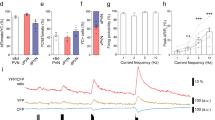Abstract
Experiments were performed to investigate evoked focal potentials in slices of rat olfactory cortex. The results showed that 1 μM corticotropin-releasing factor (CRF; corticoliberin) increases the frequency of posttetanic potentiation, which had a shorter delay phase than in control experiments. Posttetanic potentiation during perfusion with 0.1 μM corticoliberin had a longer delay phase than in control experiments.
Similar content being viewed by others
REFERENCES
N. A. Emel'yanov and M. O. Samoilov, “A molecular-cellular mechanism for long-term potentiation,” Usp. Fiziol. Nauk., 27, No. 3, 12–30 (1996).
M. I. Mityushov, N. A. Emel'yanov, A. A. Mokrushin, I. A. Boiner, and T. R. Grabaeva, Living Brain Slices [in Russian], Nauka, Leningrad (1986).
A. A. Mokrushin and M. O. Samoilov, “Peptide-dependent mechanisms of long-term post-tetanic potentiation,” Usp. Fiziol. Nauk., 30, No. 1, 3–28 (1999).
D. P. Behan, S. C. Heinrichs, J. C. Troncosi, X. J. Liu, C. H. Kawas, N. Ling, and E. B. De Souza, “Displacement of corticotropin releasing factor from its binding protein as a possible treatment for Alzheimer's disease,” Nature, 378, No. 6554, 284–287 (1995).
D. T. Chalmers, T. W. Lovenberg, and E. B. De Souza, “Localization of novel corticotropin-releasing factor receptor (CRF-2) mRNA expression to specific subcortical nuclei in rat brain: comparison with CRF1 receptor mRNA expression,” J. Neurosci., 15, No. 10, 6340–6350 (1995).
F. M. Chen, L. M. Bilezikjan, M. N. Perrin, J. Rivier, and W. Vale, “Corticotropin-releasing factor receptor-mediated stimulation of adenylyl cyclase activity in the rat brain,” Brain Res., 381, No. 1, 49–57 (1986).
J. C. Chou and E. H. Lee, “Differential involvement of hippocampal G-protein subtypes in the memory process of rats,” Neurosci., 64, No. 1, 5–15 (195).
A. J. Dunn and C. W. Berrige, “Physiological and behavioural responses to corticotropin-releasing factor administration: is CRF a mediator of anxiety or stress responses?” Brain Res. Rev., 15, No. 1, 71–100 (1990).
K. Eckart, J. Radulovic, O. Jahn, T. Blank, O. Stiedl, and J. Spiess, “Actions of CRF and its analogs,” Curr. Med. Chem., 6, No. 11, 1035–1053 (1999).
J. M. Gibbins, R. J. Woods, and P. J. Lowry, “Affinity purification of 61–and 65–kDa rat brain corticotropin-releasing factor receptors and receptor-associated G proteins,” Int. J. Biochem. Cell. Biol., 28, No. 9, 1017–1029 (1996).
M. W. Jung, J. Larson, and G. Lynch, “Long-term potentiation of monosynaptic EPSPs in rat piriform cortex in vitro,” Synapse, 6, No. 3, 279–283 (1990).
E. H. Y. Lee, C. P. Lee, H. I. Wang, and W. R. Lin, “Hippocampal CRF, Ne, and NMDA system interactions in memory processing in the rat,” Synapse, 14, No. 2, 144–153 (1993).
M. C. Olianas, G. Lampis, and P. Onali, “Coupling of corticotropin-releasing hormone receptors to adenylyl cyclase in human Y-79 retinoblastoma cells,” J. Neurochem., 64, No. 1, 391–401 (1995).
P. Onali and M. C. Olianas, “Bimodal regulation of cyclic AMP by muscarinic receptors. Involvement of multiple G proteins and different forms of adenylyl cyclase,” Life Sci., 56, No. 11–12, 973–980 (1995).
J. Radulovic, A. Ruhmann, T. Liepold, and J. Spiess, “Modulation of learning and anxiety by corticotropin-releasing factor (CRF) and stress: differential roles of CRF receptors 1 and 2,” J. Neurosci., 19, No. 12, 5016–5025 (1999).
R. Rebaudo, R. Melani, M. Balestrino, N. Izvarina, and M. Lensman, “The effects of CRF on the development of long-term potentiation in hippocampal slices,” in: Mechanisms of Adaptive Behavior (Abstracts of an International Symposium Dedicated to Academician Ivan Pavlov's 150th Anniversary), St. Petersburg, Russia, 7–9 December, 1999, pp. 59–60.
W. Vale, J. Spiess, C. Rivier, and J. Rivier, “Characterization of a 41–residue ovine hypothalamic peptide that stimulates secretion of corticotropin and endorphins,” Science, 213, No. 4514, 1394–1397 (1981).
H. L. Wang, M. J. Wayner, C. Y. Chai, and E. H. Lee, “Corticotrophin-releasing factor produces a long-lasting enhancement of synaptic efficacy in the hippocampus,” Eur. J. Neurosci., 10, No. 11, 3428–3437 (198).
Author information
Authors and Affiliations
Rights and permissions
About this article
Cite this article
Lyubimov, Y.E., Izvarina, N.L., Emel'yanov, N.A. et al. The Effects of Corticoliberin at Different Concentrations on Long-Term Potentiation in Slices of Rat Olfactory Cortex. Neurosci Behav Physiol 32, 609–612 (2002). https://doi.org/10.1023/A:1020457627521
Issue Date:
DOI: https://doi.org/10.1023/A:1020457627521




